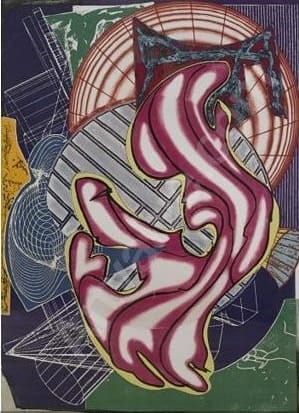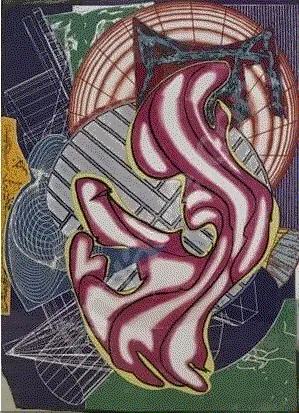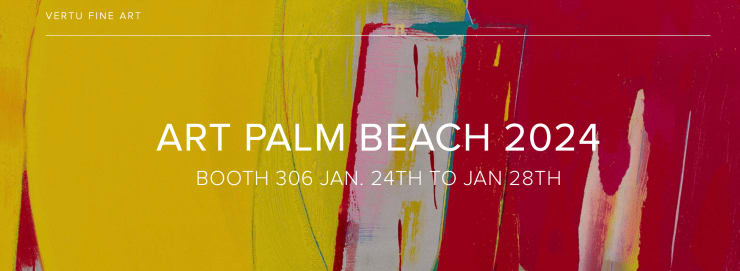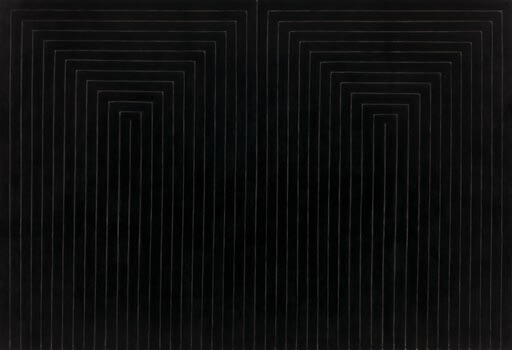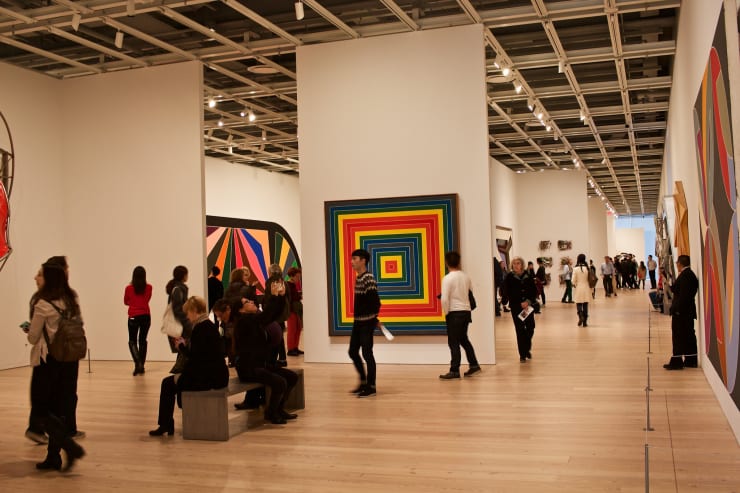Frank Stella
-
 Frank StellaEgyplosis Relief, 1996Relief etching and aquatint In colors on TGL handmade paper31 1/2 x 31 1/2 ins 80.01 x 80.01 cm
Frank StellaEgyplosis Relief, 1996Relief etching and aquatint In colors on TGL handmade paper31 1/2 x 31 1/2 ins 80.01 x 80.01 cm -
 Frank StellaStubb & Flask Kill A Right Whale, 1992Relief printed etching,aquatint and engraving on handmade TGL paper76 1/2 x 56 x 9 1/2 ins 194.31 x 142.24 x 24.13 cm
Frank StellaStubb & Flask Kill A Right Whale, 1992Relief printed etching,aquatint and engraving on handmade TGL paper76 1/2 x 56 x 9 1/2 ins 194.31 x 142.24 x 24.13 cm -
 Frank StellaA Squeeze of the Hand, 1988Serigraph/lithograph/linocut/collage72 x 54 ins 182.88 x 137.16 cm
Frank StellaA Squeeze of the Hand, 1988Serigraph/lithograph/linocut/collage72 x 54 ins 182.88 x 137.16 cm -
 frank stellaPolar Co-ordinates III, 1980Lithograph and screenprint on 320 gram Arches Cover paper38 1/2 x 38 in
frank stellaPolar Co-ordinates III, 1980Lithograph and screenprint on 320 gram Arches Cover paper38 1/2 x 38 in
97.8 x 96.5 cmEdition of 100signed and dated in pencil, lower left -
 Frank StellaSharpesville, 1973Lithograph16 x 22 ins 40.64 x 55.88 cm
Frank StellaSharpesville, 1973Lithograph16 x 22 ins 40.64 x 55.88 cm
American Artist Frank Stella is considered to be one of the country’s greatest living Abstract Expressionists. Stella is known for pioneering new expressions in minimalism, nonrepresentational painting and hybrid works that bridge the gap between sculpture and two-dimensional painting. Influenced by the likes of Jackson Pollock and Jasper Johns, Frank Stella’s works helped set a tone for the emotionally detached style of Pop Artists emerging in the 1960s, including Andy Warhol and Roy Lichtenstein.
What you see is what you see.”
— Frank Stella
Born and raised in a suburb of Boston, Frank Stella studied painting and history in high school at the prestigious Phillips Academy in Andover, MA. After graduation, Stella continued his studies at Princeton University, where he graduated with a BA degree 1958. Upon graduation, he moved to New York City, where he planned to paint for the summer, expecting to be drafted into army. Upon learning that he would not be drafted, Stella began to paint professionally.
Frank Stella’s career took off rather quickly, as four of his paintings in a series known as The Black Paintings were shown at an exhibition entitled 16 Americans at the Museum of Modern Art (MoMA) during 1959-1960. The museum purchased The Marriage of Reason and Squalor, II (1959) from the exhibition.
The Black Paintings were created by Stella using black enamel paint used to for house painting. The white pinstripes are unpainted canvas. Early in his career, Frank Stella deviated from his Contemporary Art peers whose abstractions related to objects of physicality or emotions. For Stella, who famously said, “What you see is what you see,” this non-representational philosophy separated his approach from that of others. For the Frank Stella, the art is the object and it alludes to nothing else.
In the 1960s, Stella continued to employ the pinstripe style of The Black Paintings, but created new works using aluminum and copper paint, and also a wider array of colors. Pushing the boundaries of painting, Frank Stella began painting on uniquely shaped canvases – often in the shape of a T, U, L or N. In the mid-60s, the artist made a significant change with his Irregular Polygons series of paintings, which would mark the first works on asymmetrical shaped canvases. Thus began a change in painting philosophy, moving away from the style of flatness for which Stella was known, toward new explorations of space and depth – a transformation that would be integral to the painter’s evolution.
In the early 1970s, Frank Stella developed his iconic Protractor Series of paintings using the geometric tool for which the series is named, to create half and full circles painted with fields of color. The paintings in this series are named for the circular shaped cities that Stella visited on a trip to the Middle East, inspired by Persian architecture and art. The painter’s fondness for such interweaving and interlocking shapes – and they’re illusory effects on the viewer – signified further movement away from the flat style of his prior works.
Advances in printmaking are among the many contributions Frank Stella made to the world of art throughout his career. His works in screenprinting, lithography and offset lithography inspired other artists to embrace printmaking − particularly during the earlier stages of these techniques − in the 60s and 70s. Stella’s printing expertise would come in handy as his later mixed media works often include combinations of such processes.
In the summer of 1970, a lengthy hospital stay and a gift from architect Richard Meier – a book entitled Wooden Synagogues – provided Frank Stella with inspiration for his Polish Village series of works. The book featured beautiful photographs of Polish synagogues that were destroyed by the Nazis during World War II. Each of Stella’s Polish Village works was given a name taken from a destroyed synagogue or village detailed in the book. The series of works represented a new level of the painter moving toward creating three-dimensional works made of materials atypical of fine artists during this period of time. It also demonstrated Stella’s continuous departure from the nonrepresentational styled art that the artist favored early on in his career.
Perhaps Frank Stella’s most famous series of works from the 1970s is the Exotic Bird series. The series solidified the artist’s bend toward increasingly creative use of shapes, color, textures and mixed media. As with the bold and inventive series of works that have followed, Stella has straddled the space between painter, printmaker and sculptor – sporting vast accomplishments within each medium and often, mixtures of the three.
Frank Stella continues to be praised for his prolific career and the inspiration he engenders from fellow artists. His iconic works are showcased worldwide, including an aluminum bandshell residing in Downtown Miami that was inspired by a folding Brazilian hat. In the early 1990s, Stella developed the entire décor for the Princess of Wales Theatre in Toronto that features a 10,000 square foot Frank Stella mural.
-

Remembering Frank Stella (1936-2024)
May 9, 2024Frank Stella died on Saturday, May 4, at the age of 87. He changed the way the world views art, creates art and defines art....Read more -

Carmen Herrera at the Venice Biennale
Keith Haring Mural at the Stanley Museum May 1, 2024For the first time in history, a work of Carmen Herrera (1915-2022) is on exhibit at the Venice Biennale. The Cuban-born American artist painted in...Read more -

Art Palm Beach 2024
January 24, 2024Art Palm Beach 2024 has been exciting to plan and, with more than eighty galleries from around the world exhibiting modern and contemporary art, it...Read more -

VFA at Art Palm Beach 2024
January 18, 2024Art Palm Beach is back! This year’s show will be held from January 24th to 28th at the Palm Beach County Convention Center. We’ll be...Read more -

VFA: The Excitement of Art Week 2023
December 6, 2023Miami is an exciting city, but everything gets ramped up and even more exciting during Art Week. The art, fashion, design, even the food, seems...Read more -

VFA at Art Miami 2023
November 29, 2023Vertu Fine Art will be exhibiting the finest Modern and Contemporary art at Art Miami 2023. The 33rd Edition of Art Miami 2023 runs from...Read more -

Honoring the Printmaker
April 5, 2022A current exhibit at the Albuquerque Museum pays tribute to master printers. It is their skills, talents and ability to problem solve that help to...Read more -

Equitable Building Crash
June 11, 2019Last Monday’s calamitous helicopter crash, into the roof of the 54-story Equitable Building on Seventh Avenue in Manhattan, killed the pilot, left wreckage and caused...Read more -

The Continuing Evolution of Frank Stella’s Prints
September 19, 2018Frank Stella changed the art world in so many ways. His Black Painting series launched the minimalism movement in the mid-twentieth century and his collaboration...Read more -

Frank Stella: Jasper’s Dilemma and other Stella Works at VFA
April 4, 2018Frank Stella helped to move American art through the tides of abstract expressionism by creating paintings that were not meant to represent pictorial or graphic image. In a 1964 interview he said, “My painting is based on the fact that only what can be seen there is there. It really is an object. Any painting is an object and anyone who gets involved enough in this finally has to face up to the objectness of whatever it is that he’s doing. He is making a thing … all I want anyone to get out of my paintings, and all I ever get out of them, is the fact that you can see the whole idea without any confusion …What you see is what you see.”Read more -

Frank Stella: Surprising Influences
January 24, 2017Rogier van der Weyden’s, Crucifixion Diptych, painted c. 1460, is one of Stella’s favorite paintings. It is effective, emotional and unlike any of the Early Netherlandish paintings of the fifteenth century. It’s clarity, precision and color had a profound influence on Stella’s work. After graduating from Princeton at age 22, Stella moved to New York. His frequent visits to the Frick and the Met led him to a better understanding of the great masters.Read more -

Frank Stella: Not His First Rodeo
November 4, 2015This show is not Stella’s first rodeo. In 1970, at the age of 33, Stella was the youngest artist ever to have a retrospective at...Read more


